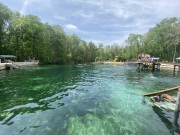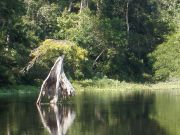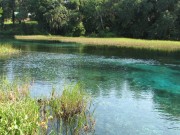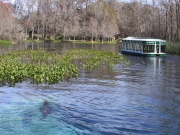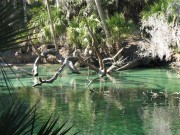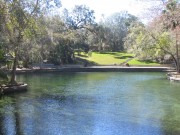Featured Aquatic Ecology Studies
WSI completed a project for the SRWMD to evaluate potential new metrics for analysis of WRV 1 (Recreation In and On the Water) and WRV 6 (Aesthetic and Scenic Attributes) as part of MFL development. This project considered a total of 18 Outstanding Florida Springs (OFSs) and priority springs and included collection and organization of all available data for each spring. These data were used to evaluate data availability, statistical ranges, and potential application in evaluating WRVs 1 and 6. Based on collected data and analysis, WSI developed metrics that could be applied to springs to define “significant harm” for WRVs 1 and 6. This project had an aggressive schedule of less than five months; including site visits, data collection, and data analysis, and WSI completed and submitted all requested deliverables on time and in a finished format for review and comment. WSI maintained this schedule through consistent communication and coordination with the SRWMD.
8 Photos
WSI developed a comprehensive monitoring plan for the Lower Withlacoochee River in Southwest Florida including collection of water quality samples, discharge measurements, long-term deployment of water quality sondes, and sediment sampling. The SWFWMD and FDEP partnered on this project providing field assistance (SWFWMD) and laboratory analysis (FDEP). A variety of samples were collected over a 36-month period at seven stations to support development of a restoration plan for the Lower Withlacoochee River. Sampling included measurement of light attenuation, bathymetry, long-term field parameters from data sondes, flow measurements using an acoustic Doppler current profiler (ADCP), water quality samples, and sediment samples. This data collection effort was modified early in the study to add two stations to better define water quality upstream of Lake Rousseau and upstream of the Rainbow River. All water quality and sediment samples were collected according to FDEP requirements and analyzed by the FDEP Laboratory. All data were summarized and evaluated as part of developing a restoration plan for the Lower Withlacoochee River that identified specific goals and actions that could be worked towards to improve the ecological condition of the river.
8 Photos
To support the development of the SWFWMD’s Minimum Flows and Levels (MFL) for Gum Slough, WSI provided ecological monitoring and data analysis for ecosystem metabolism. Four spring run segments were established for monitoring with WSI conducting site reconnaissance to select sampling stations, install data sondes, and qualitatively characterize each study segment. WSI conducted upstream/downstream metabolism measurements at each segment. Each segment received two weeks of continuous monitoring (30-minute intervals) bi-monthly over a period of six months. WSI also measured light transmission and oxygen diffusion rates in each segment. WSI prepared a summary report that included hourly rates of gross primary productivity, net primary productivity, community respiration, and photosynthetic efficiency. Data were analyzed to investigate significant relationships between dependent variables (community metabolism) and independent variables (physical, chemical, and biological variables), and to investigate differences between segments and temporal responses.
5 Photos
WSI was selected by the FWC to provide an ecological comparison of twelve first and second magnitude artesian springs. Three springs were selected in each of four water management districts for study. The study springs included: Wakulla, Ponce de Leon, Jackson Blue, Rainbow, Weeki Wachee, Homosassa, Silver, Silver Glen, De Leon, Madison Blue, Manatee, Wakulla, and Ichetucknee. Existing published data from each spring were summarized and a field reconnaissance was conducted to select sampling sites and to collect preliminary data at each spring and associated spring run. An intensive sampling effort was subsequently made at each spring. Ecosystem indices that were measured included: spring bathymetry, area, and volume; water quality and spring discharge sampling; continuous measurement of incoming solar radiation and whole spring ecosystem metabolism (primary production, respiration, photosynthetic efficiency, and oxygen diffusion); downstream export of seston, plant diversity and cover; emergence rates of macroinvertebrates, fish counts, and human use activities. Data were analyzed to compare and contrast conditions between the 12 sampled springs. Important relationships were found between spring alterations (rising nitrate and declining flows) and ecosystem response (primary productivity). The project funding partners included the FWC, the Florida Springs Initiative, the Florida Park Service, the SJRWMD, the SWFWMD, and Three Rivers, FNPC.
5 Photos
Silver Springs is one of the largest springs in Florida and one of the most visited. It is also the most studied spring in Florida with a record of physical data collection extending back nearly 100 years and extensive ecological data collected since the 1950s. WSI was part of team that conducted a comprehensive one-year study of the environmental conditions in Silver Springs and the upper Silver River to develop a quantitative analysis of changing conditions over the past 50 years and predictions of possible changes over the next 50 years. In addition to providing review for the entire project, WSI was responsible for sampling and assessing hydrologic changes and climatic factors, changes in underwater light transmittance, a broad suite of water quality parameters, aquatic macroinvertebrate emergence rates, floating macrophyte export rates, particulate carbon export rates, and whole ecosystem metabolism (primary productivity and community respiration) based on upstream-downstream dissolved oxygen changes. WSI was also responsible for reviewing and summarizing all historic data for Silver Springs, designing and constructing a database for all project data, and developing models to assess the future condition in Silver Springs based on current rates of change to surrounding land uses.
5 Photos
In support of the District’s establishment of minimum flows and levels at Volusia Blue Spring, WSI assessed the effects of spring discharge on the ecology and human use water resource values supported by the spring. Following adoption of a minimum flow regime for Blue Spring, the District implemented a Collaborative Action Plan to document the effect of changing discharge on the ecological and human use values supported by the spring. WSI provided overall coordination of the team that included District staff, the USGS, FDEP, the Florida Park Service, and various university researchers. In addition to overall coordination and report preparation, WSI conducted ecological monitoring at Blue Spring, including measurement of community metabolism (primary productivity and respiration), particulate export, light transmittance and horizontal secchi disk transparency, detailed human use activities, and nutrient loading and assimilation rates. WSI also led efforts to quantify turtle and fish population density and diversity in the spring run.
3 Photos
The Wekiva River Protection Act of 2004 required the SJRWMD to develop pollutant load reduction goals (PLRGs) for total phosphorus and nitrate nitrogen in the Wekiva River System (Wekiwa Springs, Wekiva River, and Rock Springs Run). WSI developed a plan of study for this work and conducted the monitoring and assessment for the PLRG analysis. The study plan included a comprehensive review of existing physical, chemical, and biological information from these spring run ecosystems. Over a period of two years of intensive field data collection, WSI completed the following studies in the two spring runs and at two reference sites (Juniper and Alexander Springs): stream channel characterization (channel depth and cross sections, sediment texture and nutrient concentrations, and velocity regime), water quality sampling and characterization, whole spring ecosystem metabolism (primary productivity, respiration, oxygen diffusion, and photosynthetic efficiency), nitrogen and phosphorus assimilation rates, plant community characterization, continuous water level monitoring, and discharge measurements. WSI also designed and deployed in-stream mesocosms for the replicated assessment of the effects of nitrogen and phosphorus concentrations on plant and algal primary productivity and respiration. Based on these studies, WSI recommended phosphorus and nitrogen PLRGs to the District.
7 Photos


